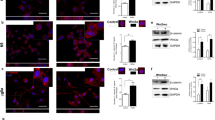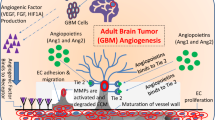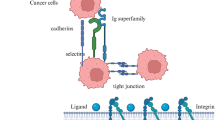Abstract
The L1CAM cell adhesion/recognition molecule (L1, CD171) and fibroblast growth factor receptor (FGFR) both are expressed by human high-grade glioma cells, but their potential actions in controlling cell behavior have not been linked. L1 actions in cancer cells have been attributed mainly to integrin receptors, and we demonstrated previously that L1-stimulated glioma cell migration correlates with integrin expression, increased focal adhesion kinase activation and focal complex turnover. Our analyses of datasets revealed FGFR is overexpressed in glioma regardless of grade, while ADAM10 metalloprotease expression increases with glioma grade. Here, we used dominant-negative and short hairpin RNA approaches to inhibit the activation of FGFR1 and expression of L1, respectively. An L1 peptide that inhibits L1-FGFR interaction and PD173074, a chemical inhibitor of FGFR1 activity, also were used to elucidate the involvement of L1-FGFR interactions on glioma cell behavior. Time-lapse cell motility studies and flow cytometry cell cycle analyses showed that L1 operates to increase glioma cell motility and proliferation through FGFR activation. Shutdown of both L1 expression and FGFR activity in glioma cells resulted in a complete termination of cell migration in vitro. These studies show for the first time that soluble L1 ectodomain (L1LE) acts on glioma cells through FGFRs, and that FGFRs are used by glioma cells for increasing motility as well as proliferation in response to activation by L1LE ligand. Thus, effective treatment of high-grade glioma may require simultaneous targeting of L1, FGFRs, and integrin receptors, which would reduce glioma cell motility as well as proliferation.





Similar content being viewed by others
Abbreviations
- FGFR:
-
Fibroblast growth factor receptor
- L1LE:
-
L1 long ectodomain
- GBM:
-
Glioblastoma multiforme
- FN:
-
Fibronectin-like repeats
- CAMs:
-
Cell adhesion molecules
- CHD:
-
CAM homology domains
References
Neuropathol Claes A, Idema AJ, Wesseling P (2007) Diffuse glioma growth: a guerilla war. Acta 114(5):443–458
Kleihues P, Soylemezoglu F, Schauble B, Scheithauer BW, Burger PC (1995) Histopathology, classification, and grading of gliomas. Glia 15(3):211–221
Wen P, Fine HA, Black PM, Shrieve DC, Alexander E, Loeffler JS (1995) High-grade astrocytomas. Neurol Clin 13(4):875–900
Bao S, Wu Q, Li Z, Sathornsumetee S, Wang H, McLendon RE, Hjelmeland AB, Rich JN (2008) Targeting cancer stem cells through L1CAM suppresses glioma growth. Cancer Res 68(15):6043–6048
Wen PY, Kesari S (2008) Malignant gliomas in adults. N Engl J Med 359(5):492–507
Yuan X, Curtin J, Xiong Y, Liu G, Waschsmann-Hogiu S, Farkas DL, Black KL, Yu JS (2004) Isolation of cancer stem cells from adult glioblastoma multiforme. Oncogene 23(58):9392–9400
Ahluwalia MS, de Groot J, Liu WM, Gladson CL (2010) Targeting SRC in glioblastoma tumors and brain metastases: rationale and preclinical studies. Cancer Lett 298(2):139–149
Holland EC (2000) Glioblastoma multiforme: the terminator. Proc Natl Acad Sci USA 97(12):6242–6244
Faissner A, Teplow DB, Kubler D, Keilhauer G, Kinzel V, Schachner M (1985) Biosynthesis and membrane topography of the neural cell adhesion molecule L1. EMBO J 4(12):3105–3113
Moos M, Tacke R, Scherner H, Teplow D, Gruth K, Schachner M (1988) Neural adhesion molecule L1 as a member of the immunoglobulin superfamily with binding domains similar to fibronectin. Nature 334(6184):701–703
Schmid RS, Maness PF (2008) L1 and NCAM adhesion molecules as signaling coreceptors in neuronal migration and process outgrowth. Curr Opin Neurobiol 18(3):245–250
Herron LR, Hill M, Davey F, Gunn-Moore FJ (2009) The intracellular interactions of the L1 family of cell adhesion molecules. Biochem J 419(3):3–519
Riedle S, Kiefel H, Gast D, Bondong S, Wolterink S, Gutwein P, Altevogt P (2009) Nuclear translocation and signalling of L1-CAM in human carcinoma cells requires ADAM10 and presenilin/gammasecretase activity. Biochem J 420(3):391–402
Brummendorf T, Kenwrick S, Rathjen FG (1988) Neural cell recognition molecule L1; from cell biology to human hereditary brain malformation. Curr Opin Neurobiol 8(1):87–97
Haspel J, Grumet M (2003) The L1CAM extracellular region: a multidomain protein with modular and cooperative binding modes. Front Biosci 8:s1210–s1225
Hortsch M (1996) The L1 family of neural cell adhesion molecules: old proteins performing new tricks. Neuron 17(4):587–593
Gavert N, Ben-Shmuel A, Raveh S, Ben-Ze’ev A (2008) L1-CAM in cancerous tissues. Expert Opin Biol Ther 8(11):1749–1757
Yang M, Li Y, Chilukuri K, Brady OA, Boulos MI, Kappes JC, Galileo DS (2011) L1 stimulation of human glioma cell motility correlates with FAK activation. J Neurooncol 105(1):27–44
Zecchini S, Bianchi M, Colombo N, Fasani R, Goisis G, Casadio C, Viale G, Liu J, Herlyn M, Godwin AK, Nuciforo PG, Cavallaro U (2008) The differential role of L1 in ovarian carcinoma and normal ovarian surface epithelium. Cancer Res 68(4):1110–1118
Li Y, Galileo DS (2010) Soluble L1CAM promotes breast cancer cell adhesion and migration in vitro, but not invasion. Cancer Cell Int 15(10):34
Houssaint E, Blanquet PR, Champion-Arnaud R, Gesnel MC, Torriglia A, Courtois Y, Breathnach R (1990) Related fibroblast growth factor receptor genes exist in the human genome. Proc Natl Acad Sci USA 87(20):8180–8184
Johnson DE, Lu J, Chen H, Werner S, Williams LT (1991) The human fibroblast growth factor receptor genes: a common structural arrangement underlies the mechanisms for generating receptor forms that differ in their third immunoglobulin domain. Mol Cell Bio 11(9):4627–4634
Keegan K, Johnson DE, Williams LT, Hayman MJ (1991) Isolation of additional member of the fibroblast growth factor receptor family, FGFR-3. Proc Natl Acad Sci USA 88(4):1095–1099
Partanen J, Makela TP, Erola E, Kohonen J, Hirovenen H, Claesson-Welsh L, Alitalo K (1991) FGFR-4, a novel acidic fibroblast growth factor receptor with a distinct expression pattern. EMBO J 10(6):1347–1354
McKeehan WL, Wang F, Kan M (1998) The heparan sulfate-fibroblast growth factor family: diversity of structure and function. Prog Nucleic Acid Res Mol Biol 59:135–176
Doherty P, Walsh FS (1996) CAM-FGF receptor interactions: a model for axonal growth. Mol Cell Neurosci 8(2/3):99–111
Doherty P, Williams E, Walsh FS (1995) A soluble chimeric form of the L1 glycoprotein stimulates neurite outgrowth. Neuron 14(1):57–66
Williams EJ, Furness J, Walsh FS, Doherty P (1994) Activation of the FGF receptor underlies neurite outgrowth stimulated by L1, N-CAM, and N-cadherin. Neuron 13(3):583–594
Doherty P, Smith P, Walsh FS (1996) Shared cell adhesion molecule (CAM) homology domains point to CAMs signalling via FGF receptors. Perspect Dev Neurobiol 4(2–3):157–168
Hall H, Walsh FS, Doherty P (1996) Review: a role for the FGF receptor in the axonal growth response stimulated by cell adhesion molecules? Cell Adhes Commun 3(6):441–450
Kulahin N, Li S, Kiselyov V, Bock E, Berezin V (2009) Identification of neural cell adhesion molecule L1-derived neuritigenic ligands of the fibroblast growth factor receptor. J Neurosci Res 87(8):1806–1812
Kulahin N, Li S, Hinsby A, Kiselyov V, Berezin V, Bock E (2008) Fibronectin type III (FN3) modules of the neuronal cell adhesion molecule L1 interact directly with the fibroblast growth factor (FGF) receptor. Mol Cell Neurosci 37(3):528–536
Kiselyov VV, Skladchikova G, Hinsby AM, Jensen PH, Kulahin N, Soroka V, Pedersen N, Tsetlin V, Poulsen FM, Berezin V, Bock E (2003) Structural basis for a direct interaction between FGFR1 and NCAM and evidence for a regulatory role of ATP. Structure 11(6):691–701
Saffell JL, Williams EJ, Mason IJ, Walsh FS, Doherty P (1997) Expression of a dominant negative FGF receptor inhibits axonal growth and FGF receptor phosphorylation stimulated by CAMs. Neuron 18(2):231–242
Rand V, Huang J, Stockwell T, Ferriera S, Buzko O, Levy S, Busam D, Li K, Edwards JB, Eberhart C, Murphy KM, Tsiamouri A, Beeson K, Simpson AJ, Venter JC, Riggins GJ, Strausberg RL (2005) Sequence survey of receptor tyrosine kinases reveals mutations in glioblastomas. Proc Natl Acad Sci USA 102(40):14344–14349
Cancer Genome Atlas Research Network (2008) Comprehensive genomic characterization defines human glioblastoma genes and core pathways. Nature 455(7216):1061–1068
Auguste P, Gürsel DB, Lemière S, Reimers D, Cuevas P, Carceller F, Di Santo JP, Bikfalvi A (2001) Inhibition of fibroblast growth factor/fibroblast growth factor receptor activity in glioma cells impedes tumor growth by both angiogenesis-dependent and -independent mechanisms. Cancer Res 61(4):1717–1726
Rousseau B, Larrieu-Lahargue F, Javerzat S, Guilhem-Ducléon F, Beermann F, Bikfalvi A (2004) The tyrp1-Tag/tyrp1-FGFR1-DN bigenic mouse: a model for selective inhibition of tumor development, angiogenesis, and invasion into the neural tissue by blockade of fibroblast growth factor receptor activity. Cancer Res 64(7):2490–2495
Loilome W, Joshi AD, ap Rhys CM, Piccirillo S, Vescovi AL, Gallia GL, Riggins GJ (2009) Glioblastoma cell growth is suppressed by disruption of fibroblast growth factor pathway signaling. J Neurooncol 94(3):359–366
Morrison RS, Yamaguchi F, Bruner JM, Tang M, McKeehan W, Berger MS (1994) Fibroblast growth factor receptor gene expression and immunoreactivity are elevated in human glioblastoma multiforme. Cancer Res 54(10):2794–2799
Yang M, Adla S, Temburni MK, Patel VP, Lagow EL, Brady OA, Tian J, Boulos MI, Galileo DS (2009) Stimulation of glioma cell motility by expression, proteolysis, and release of the L1 neural cell recognition molecule. Cancer Cell Int 9:27
Stein GH (1979) T98G: an anchorage-independent human tumor cell line that exhibits stationary phase G1 arrest in vitro. J Cell Physiol 99(1):43–54
Ponten J, Macintyre EH (1968) Long term culture of normal and neoplastic human glia. Acta Pathol Microbiol Scand 74(4):465–486
Mohammadi M, Froum S, Hamby JM, Schroeder MC, Panek RL, Lu GH, Eliseenkova AV, Green D, Schlessinger J, Hubbard SR (1998) Crystal structure of an angiogenesis inhibitor bound to the FGF receptor tyrosine kinase domain. EMBO J 17(20):5896–5904
Bansal R, Magge S, Winkler S (2003) Specific inhibitor of FGF receptor signaling: FGF-2-mediated effects on proliferation, differentiation, and MAPK activation are inhibited by PD173074 in oligodendrocyte-lineage cells. J Neurosci Res 74(4):486–493
Pasquale EB, Singer SJ (1989) Identification of a developmentally regulated protein-tyrosine kinase by using anti-phosphotyrosine antibodies to screen a cDNA expression library. Proc Natl Acad Sci USA 86(14):5449–5453
Szymczak AL, Workman CJ, Wang Y, Vignali KM, Dilioglou S, Vanin EF, Vignali DA (2004) Correction of multi-gene deficiency in vivo using a single ‘self-cleaving’ 2A peptide-based retroviral vector. Nat Biotechnol 22(5):589–594
Chen C, Okayama H (1987) High-efficiency transformation of mammalian cells by plasmid DNA. Mol Cell Biol 7(8):2745–2752
Fotos JS, Patel VP, Karin NJ, Temburni MK, Koh JT, Galileo DS (2006) Automated time-lapse microscopy and high-resolution tracking of cell migration. Cytotechnology 51:7–19
Ueno H, Gunn M, Dell K, Tseng A Jr, Williams L (1992) A truncated form of fibroblast growth factor receptor 1 inhibits signal transduction by multiple types of fibroblast growth factor receptor. J Biol Chem 267(3):1470–1476
Suyama K, Shapiro I, Guttman M, Hazan RB (2002) A signaling pathway leading to metastasis is controlled by N-cadherin and the FGF receptor. Cancer Cell 2(4):301–314
Wang W, Zhu NL, Chua J, Swenson S, Costa FK, Schmitmeier S, Sosnowski BA, Shichinohe T, Kasahara N, Chen TC (2005) Retargeting of adenoviral vector using basic fibroblast growth factor ligand for malignant glioma gene therapy. J Neurosurg 103(6):1058–1066
Murphy PR, Knee RS (1995) Basic fibroblast growth factor binding and processing by human glioma cells. Mol Cell Endocrinol 114(1–2):193–203
Yamada SM, Yamaguchi F, Brown R, Berger MS, Morrison RS (1999) Suppression of glioblastoma cell growth following antisense oligonucleotide-mediated inhibition of fibroblast growth factor receptor expression. Glia 28(1):66–76
Walton NM, Sutter BM, Chen HX, Chang LJ, Roper SN, Scheffler B, Steindler DA (2006) Derivation and large-scale expansion of multipotent astroglial neural progenitors from adult human brain. Development 133(18):3671–3681
Morrison RS, Yamaguchi F, Saya H, Bruner JM, Yahanda AM, Donehower LA, Berger M (1994) Basic fibroblast growth factor and fibroblast growth factor receptor I are implicated in the growth of human astrocytomas. J Neurooncol 18(3):207–216
Witsch E, Sela M, Yarden Y (2010) Roles for growth factors in cancer progression. Physiology 25(2):85–101
Haglund K, Rusten TE, Stenmark H (2007) Aberrant receptor signaling and trafficking as mechanisms in oncogenesis. Crit Rev Oncog 13(1):39–74
Wesche J, Haglund K, Haugsten EM (2011) Fibroblast growth factors and their receptors in cancer. Biochem J 437(2):199–213
Yan G, Fukabori Y, McBride G, Nikolaropolous S, McKeehan W (1993) Exon switching and activation of stromal and embryonic fibroblast growth factor (FGF) FGF receptor genes in prostate epithelial cells accompany stromal independence and malignancy. Mol Cell Biol 13(8):4513–4522
Zecchini S, Bombardelli L, Decio A, Bianchi M, Mazzarol G, Sanguineti F, Aletti G, Maddaluno L, Berezin V, Bock E, Casadio C, Viale G, Colombo N, Giavazzi R, Cavallaro U (2011) The adhesion molecule NCAM promotes ovarian cancer progression via FGFR signalling. EMBO Mol Med 3(8):480–494
Cretu A, Fotos JS, Little BW, Galileo DS (2005) Human and rat glioma growth, invasion, and vascularization in a novel chick embryo brain tumor model. Clin Exper Metastasis 22(3):225–236
Mechtersheimer S, Gutwein P, Agmon-Levin N, Stoeck A, Oleszewski M, Riedle S, Postina R, Fahrenholz F, Fogel M, Lemmon V, Altevogt P (2001) Ectodomain shedding of L1 adhesion molecule promotes cell migration by autocrine binding to integrins. J Cell Biol 155(4):661–673
Acknowledgments
The authors would like to thank Dr. Elena Pasquale at the Sanford Burnham Medical Research Institute for the cek-1 plasmid. This work was funded by grant Number 2 P20 RR016472 under the INBRE program of the National Center for Research Resources (NCRR), a component of the National Institutes of Health (NIH), and by research resources of the Genetically Defined Microbe and Expression Core of the UAB Mucosal HIV and Immunobiology Center (R24 DK64400).
Conflict of interest
The authors declare that they have no conflict of interest.
Author information
Authors and Affiliations
Corresponding author
Electronic supplementary material
Below is the link to the electronic supplementary material.
Supplementary material 3 (AVI 28.3 mb)
Supplementary material 3 (AVI 34 mb)
Rights and permissions
About this article
Cite this article
Mohanan, V., Temburni, M.K., Kappes, J.C. et al. L1CAM stimulates glioma cell motility and proliferation through the fibroblast growth factor receptor. Clin Exp Metastasis 30, 507–520 (2013). https://doi.org/10.1007/s10585-012-9555-4
Received:
Accepted:
Published:
Issue Date:
DOI: https://doi.org/10.1007/s10585-012-9555-4




